Physical Sciences P1 Grade 12 Questions - NSC Exams Past Papers and Memos September 2019 Preparatory Examinations
Share via Whatsapp Join our WhatsApp Group Join our Telegram GroupINSTRUCTIONS AND INFORMATION
- Write your full NAME and SURNAME in the appropriate space on the ANSWER BOOK.
- This question paper consists of ELEVEN questions. Answer ALL the questions in the ANSWER BOOK.
- Start EACH question on a NEW page.
- Number the answers correctly according to the numbering system used in this question paper.
- Leave ONE line between two sub-questions, e.g. between QUESTION 2.1 and QUESTION 2.2.
- You may use a non-programmable calculator.
- You may use appropriate mathematical instruments.
- Show ALL formulae and substitutions in ALL calculations.
- Round off your final numerical answers to a minimum of TWO decimal places.
- Give brief motivations, discussions, et cetera where required.
- You are advised to use the attached DATA SHEETS.
- Write neatly and legibly.
QUESTIONS
QUESTION 1: MULTIPLE-CHOICE QUESTIONS
Four possible options are provided as answers to the following questions. Choose the answer and write only the letter (A–D) next to the question number (1.1–1.10) in the ANSWER BOOK, for example 1.11 D.
1.1 An object of mass m remains at rest when a force of magnitude F acts on it, as shown in the diagram below.
Which ONE of the following forces will increase if the force F acting on the object increases and the object still remains at rest?
- Normal force
- Gravitational force
- Static frictional force
- Kinetic frictional force (2)
1.2 A ball of mass m is thrown vertically upwards at a certain velocity.
Which ONE of the following physical quantities is not equal to zero when the ball reaches its maximum height?
- Net force
- Momentum
- Velocity
- Kinetic energy (2)
1.3 The graph below represents the net force acting on an object over a period of time.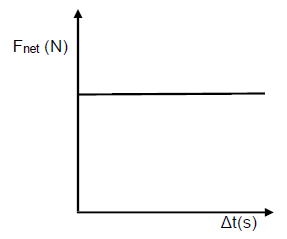
The area under the graph represents the object’s …
- momentum.
- impulse.
- rate of change of momentum.
- acceleration. (2)
1.4 Consider the following scenarios.
- A rocket accelerates through space.
- A brick falls freely from the top of a building to the ground.
- A learner moves around in the classroom carrying his school bag.
- A girl moves a wheelbarrow by pushing it in a straight line.
In which ONE of the scenarios above is work NOT being done on the object?- I
- II
- III
- IV (2)
1.5 A ball is thrown vertically upwards at a certain velocity.
Which ONE of the following is TRUE regarding mechanical energy and kinetic energy of the ball during its motion? Ignore air resistance.
MECHANICAL ENERGY | KINETIC ENERGY | |
A | Remains the same | Remains the same |
B | Increases | Decreases |
C | Decreases | Increases |
D | Remains the same | Decreases |
(2)
1.6 An observer stands at a distance x from a stationary ambulance which is sounding its siren at a certain frequency at an accident scene.
How does the pitch of the sound as heard by the observer compare with that which the siren produces?
- Equal to
- Greater than
- Less than
- Equal to zero (2)
1.7 Three identical point charges are arranged as shown in the diagram below, in a vacuum.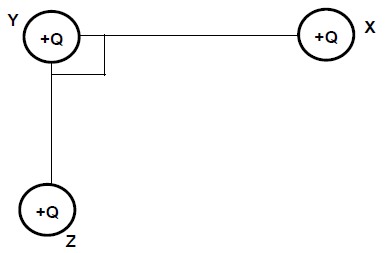
Which ONE of the following vector diagrams, NOT DRAWN TO SCALE, represents the electrostatic forces acting on sphere Y as well as the net electrostatic force acting on sphere Y?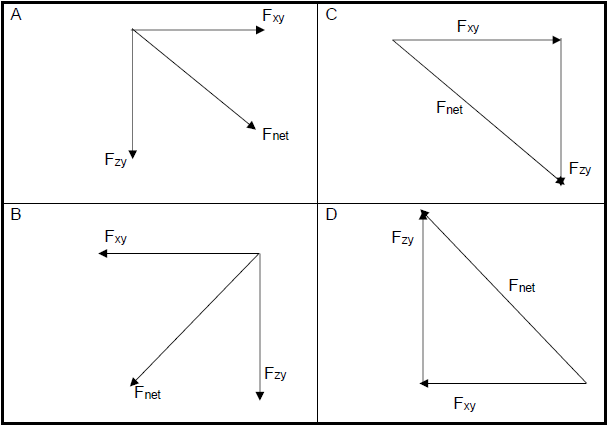 (2)
(2)
1.8 In the circuit diagram below the battery has an emf (ε) and internal resistance r. The ammeter and voltmeter both register readings. The resistance of the connecting wires can be ignored.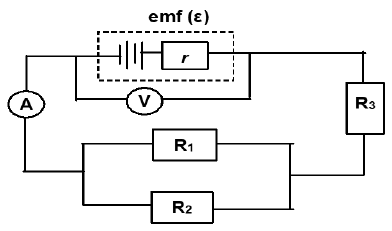
How will the reading on ammeter A and voltmeter V change if resistor R3 is removed from the circuit?
AMMETER READING | VOLTMETER READING | |
A | Decrease | Increase |
B | Increase | Decrease |
C | Increase | Remain the sane |
D | Remain the same | Decrease |
(2)
1.9 A coil is rotating in a uniform magnetic field and emf is induced in the coil.
Which ONE of the following is TRUE about the induced emf and position of the coil relative to the magnetic field?
Induced emf (V) | Position of coil relative to the magnetic field | |
A | Maximum | 0º |
B | Zero | 45º |
C | Maximum | 90º |
D | Zero | 60º |
(2)
1.10 Light from a 40 W blue light source is incident on a cathode of a photo-cell which is connected to an ammeter in a circuit as shown below. The ammeter does NOT show any reading.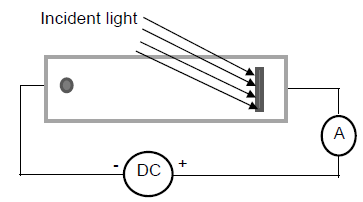
Which ONE of the light sources below is likely to cause the ammeter to show a reading?
- A 60 W blue light source
- A 100 W green light source
- A 150 W red light source
- A 40 W ultraviolet light source (2)
[20]
QUESTION 2 (Start on a NEW page.)
A block of mass m kg is placed on a rough horizontal surface. The block of mass m kg is connected to a 12 kg block by means of a light inextensible string passing over a light frictionless pulley, as shown below. A force of 88 N is applied at an angle θ to the horizontal to keep the 12 kg mass moving downwards at a CONSTANT VELOCITY.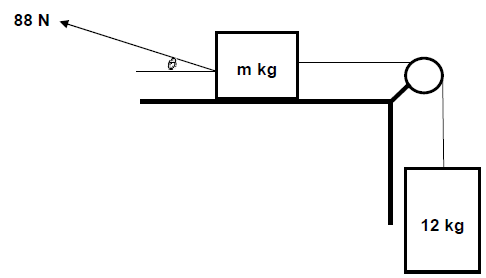
2.1 State Newton’s First Law of motion in words. (2)
2.2 Draw a labelled free-body diagram for the block of mass m. (5)
A constant frictional force of 32 N acts on block of mass m.
2.3 Calculate the magnitude of the angle θ that will keep the system moving at constant velocity. (5)
The coefficient of kinetic friction between block of mass m and the surface is 0,12.
2.4 Calculate the mass, m, of the block. (4)
2.5 How will the coefficient of kinetic friction be affected if the angle θ increases? Choose from: INCREASE, DECREASE or REMAIN THE SAME. (1)
[17]
QUESTION 3 (Start on a NEW page.)
An object is fired vertically upwards with a velocity of 24 m.s-1. After 1,5 s it enters the branches of a tree. It emerges from the highest point of the tree and continues vertically upwards to a maximum height of 2 m above the tree as shown in the diagram below. Ignore the effects of air resistance and any other forms of friction experienced by the object during its motion.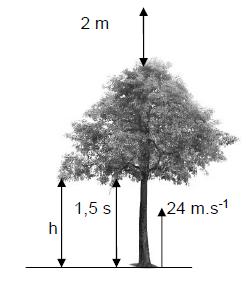
3.1 Calculate the:
3.1.1 Velocity with which the object emerges from the branches of the tree (4)
3.1.2 Height h above the ground at which the object enters the branches of the tree (4)
3.2 Calculate the height of the tree. (6)
[14]
QUESTION 4 (Start on a NEW page.)
Two ballet dancers, A of mass 52,5 kg moving with a velocity of v m.s-1 in a straight line to the east and B of mass 42 kg moving with a velocity of 4 m.s-1 to the west in a straight line, approach each other as shown in FIGURE 1.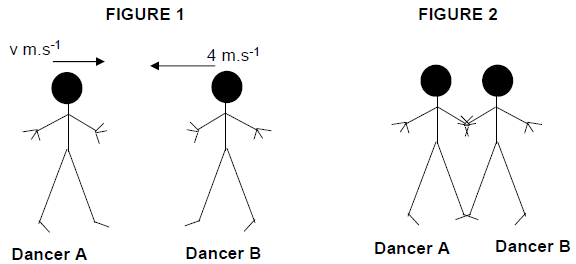
The two dancers grabbed each other and came to rest as shown in FIGURE 2. Ignore the effects of friction.
4.1 State the principle of conservation of linear momentum in words. (2)
4.2 Calculate the velocity of dancer A in FIGURE 1. (4)
After grabbing each other, dancer A pushed dancer B away with a net force of 670 N in 0,5 seconds and dancer A moves to the west, as shown in FIGURE 3.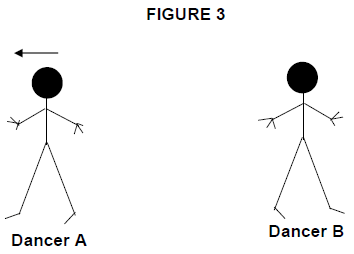
4.3 What is the force exerted by dancer B on dancer A? (1)
4.4 Calculate the magnitude of the velocity of dancer B in FIGURE 3. (4)
[11]
QUESTION 5 (Start on a NEW page.)
A steel ball of mass1,5 kg attached to an inextensible string hangs from a ceiling. The ball is held at a height of 3 m, at point A, above a horizontal table that has a 1,5 kg crate resting on it. The steel ball is released and it collides with the crate at point B. The collision is ELASTIC. The crate then moves to the left and attains a velocity of 6,2 m.s-1 after moving a certain distance, as shown in the diagram below.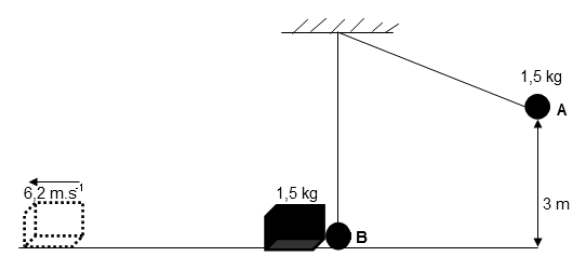
5.1 State the principle of conservation of mechanical energy in words. (2)
5.2 Calculate the work done by the gravitational force in moving the steel ball from point A to B. (3)
5.3 Define the term non-conservative force. (2)
5.4 Calculate the work done by friction in moving the crate. (5)
[12]
QUESTION 6 (Start on a NEW page.)
A group of learners conducted an experiment to determine the speed of sound on a particular day. At a particular point they placed a sound source emitting sound at a certain frequency. One learner walks away from the sound source at constant velocity with a detector which registers the frequency of the sound detected.
The graph below shows the detected frequencies versus time.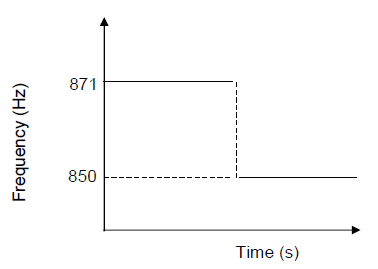
6.1 Define Doppler effect in words. (2)
6.2 Write down the frequency of the source. (1)
6.3 Explain in terms of wave motion why frequencies. the detector registers different (3)
Another learner records the time taken for the first learner to move from the point of the sound source to a particular point.
The graph below shows the position-time graph of the motion.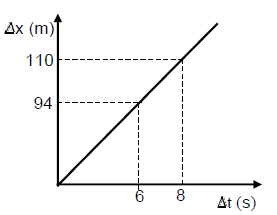
6.4 Calculate the velocity of sound on that particular day. (7)
6.5 Name TWO applications of Doppler effect in the medical field. (2) [15]
QUESTION 7 (Start on a NEW page.)
Two identical spheres, carrying equal charges, are held in a vertical position by means of an inextensible string as shown in FIGURE 1. When the spheres are released, they repel each other and come to rest with their centres 200 mm apart as shown in FIGURE 2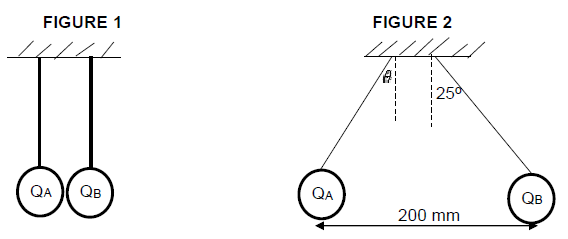
7.1 Write down the magnitude of angle, θ. (1)
7.2 State Coulomb’s law in words. (2) The tension in each string in FIGURE 2 is 480 N.
7.3 Calculate the charge on each sphere. (5)
7.4 An electron placed at point X experiences an acceleration as shown in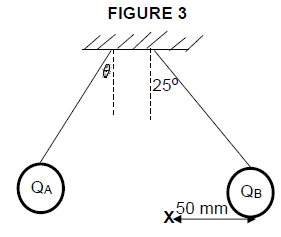
Calculate the:
7.4.1 Net electric field at point X, 50 mm from QB (5)
7.4.2 Acceleration of the electron (5)
[18]
QUESTION 8 (Start on a NEW page.)
A shaving machine is rated 60 V. The circuit diagram below represents a circuit used to provide a maximum voltage required by the shaving machine.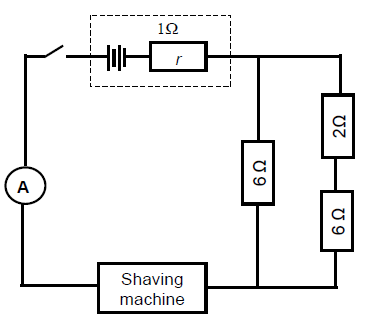
8.1 Calculate the effective resistance of the parallel network. (3)
8.2 The cost for operating the shaving machine for 5 hours per day over 5 days is R6,75. The price of electricity is R1,50 per unit (1 kWh).
Calculate the:
8.2.1 Power rating of the shaving machine (4)
8.2.2 Reading on the ammeter (3)
8.3 In order to save money, it was decided to use a battery since the machine can operate on direct current.
Calculate the:
8.3.1 Emf of the power source (battery) that should be used (5)
8.3.2 Resistance of the shaving machine (3)
[18]
QUESTION 9 (Start on a NEW page.)
The simplified diagram below represents a generator.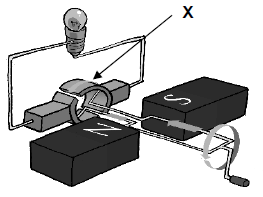
9.1 State the energy conversion that takes place while the generator is in operation. (2)
9.2 Write down the function of the component labeled X. (1)
9.3 Draw a graph of the induced emf versus time for ONE complete cycle for this type of generator. (2)
9.4 State ONE way in which the induced emf can be increased. (1)
[6]
QUESTION 10 (Start on a NEW page.)
A hair dryer is rated 2 000 W, 230 V.
10.1 Define root mean square voltage of an AC source. (2)
10.2 Calculate the maximum current that passes through the dryer when in use. (4)
[6]
QUESTION 11 (Start on a NEW page.)
The threshold frequency of a certain metal is 1,50 x 1014 Hz.
11.1 Define the term threshold frequency. (2)
11.2 Calculate the work function of the metal. (3)
11.3 Light with a wavelength of 540 nm is incident on the metal. Calculate the velocity of the ejected photoelectrons. (5)
11.4 Draw a graph that represents the relationship between the frequency and maximum kinetic energy of the emitted photoelectrons. Label the intercept of
the graph on the horizontal axis. (3)
[13]
TOTAL: 150
DATA FOR PHYSICAL SCIENCES
PAPER 1 (PHYSICS)
TABLE 1: PHYSICAL CONSTANTS
NAME | SYMBOL | VALUE |
Acceleration due to gravity | g | 9,8 m•s-2 |
Universal gravitational constant | G | 6,67 x 10-11 N•m2•kg-2 |
Speed of light in a vacuum | c | 3,0 x 108 m•s-1 |
Planck's constant | h | 6,63 x 10-34 J•s |
Coulomb's constant | k | 9,0 x 109 N•m2•C-2 |
Charge on electron | e | -1,6 x 10-19 C |
Electron mass | me | 9,11 x 10-31 kg |
Mass of earth | M | 5,98 x 1024 kg |
Radius of earth | RE | 6,38 x 103 km |
TABLE 2: FORMULAE
MOTION
FORCE
WORK, ENERGY AND POWER
WAVES, SOUND AND LIGHT
ELECTROSTATICS![]()
ELECTRIC CIRCUITS
ALTERNATING CURRENT